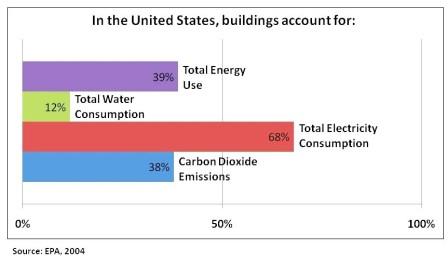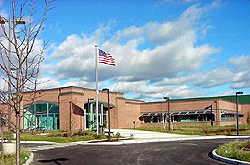Sustainable
Last updated: 10-13-2008
Overview
Building construction and operation have an enormous direct and indirect impact on the environment. As illustrated in the figure below, buildings not only use resources such as energy and raw materials, they also generate waste and potentially harmful atmospheric emissions. As economy and population continue to expand, designers and builders face a unique challenge to meet demands for new and renovated facilities that are accessible, secure, healthy, and productive while minimizing their impact on the environment.

Recent answers to this challenge call for an integrated, synergistic approach that considers all phases of the facility life cycle. This "sustainable" approach supports an increased commitment to environmental stewardship and conservation, and results in an optimal balance of cost, environmental, societal, and human benefits while meeting the mission and function of the intended facility or infrastructure.
The main objectives of sustainable design are to avoid resource depletion of energy, water, and raw materials; prevent environmental degradation caused by facilities and infrastructure throughout their life cycle; and create built environments that are livable, comfortable, safe, and productive.

EPA's New England Regional Laboratory (NERL) achieved a LEED Version 1.0 Gold rating. From conception the project was charged to "make use of the best commercially-available materials and technologies to minimize consumption of energy and resources and maximize use of natural, recycled and non-toxic materials." Chelmsford, MA
While the definition of what constitutes sustainable building design is constantly changing, there are six fundamental principles that nearly everyone agrees on.
- Optimize Site Potential
Creating sustainable buildings starts with proper site selection, including consideration of the reuse or rehabilitation of existing buildings. The location, orientation, and landscaping of a building affect the local ecosystems, transportation methods, and energy use. Incorporate Smart growth principles in the project development process, whether it be a single building, campus or military base. Siting for physical security has become a critical issue in optimizing site design. The location of access roads, parking, vehicle barriers, and perimeter lighting must be integrated into the design along with sustainable site considerations. Site design for security cannot be an afterthought. Along with site design for sustainability, it must be addressed in the preliminary design phase to achieve a successful project. - Optimize Energy Use
With America's supply of fossil fuel dwindling, concerns for energy security increasing, and the impact of greenhouse gases on world climate rising, it is essential to find ways to reduce load, increase efficiency, and utilize renewable energy resources in federal facilities. - Protect and Conserve Water
In many parts of the country, fresh water is an increasingly scarce resource. A sustainable building should reduce, control, or treat site-runoff, use water efficiently, and reuse or recycle water for on-site use when feasible. - Use Environmentally Preferable Products
A sustainable building should be constructed of materials that minimize life-cycle environmental impacts such as global warming, resource depletion, and human toxicity. These environmentally preferable materials are defined by Executive Order 13423 to be "products or services that have a lesser or reduced effect on human health and the environment when compared with competing products or services that serve the same purpose." As such, they contribute to improved worker safety and health, reduced liabilities, reduced disposal costs, and achievement of environmental goals. - Enhance Indoor Environmental Quality (IEQ)
The indoor environmental quality (IEQ) of a building has a significant impact on occupant health, comfort, and productivity. Among other attributes, a sustainable building should maximize daylighting; have appropriate ventilation and moisture control; and avoid the use of materials with high-VOC emissions. Additional consideration must now be given to ventilation and filtration to mitigate chemical, biological, and radiological attack. - Optimize Operational and Maintenance Practices
Incorporating operating and maintenance considerations into the design of a facility will greatly contribute to improved working environments, higher productivity, and reduced energy and resource costs. Designers are encouraged to specify materials and systems that simplify and reduce maintenance requirements; require less water, energy, and toxic chemicals and cleaners to maintain; and are cost-effective and reduce life-cycle costs.
RELEVANT CODES AND STANDARDS
- ASTM E2432—Standard Guide for the General Principles of Sustainability Relative to Building
- Energy Independence and Security Act (EISA 2007) (PDF 738 KB, 310 pgs).
- Energy Policy Act of 2005 (PDF 1.9 MB, 550 pgs)
- Executive Order 13423, "Strengthening Federal Environmental, Energy, and Transportation Management"
Major Resources
WBDG
Building / Space Types
Applicable to most building types and space types.
Design Objectives
Information in these Sustainable pages must be considered together with other design objectives and within a total project context in order to achieve quality, high—performance buildings.
Products and Systems
Building Envelope Design Guide—Sustainability of the Building Envelope
Federal Green Construction Guide for Specifiers:
- 01 10 00 (01100) Summary
- 01 30 00 (01300) Administrative Requirements
- 01 74 19 (01351) Construction Waste Management
- 01 40 00 (01400) Quality Requirements
- 01 41 00 (01411) Regulatory Requirements
- 01 42 00 (01421) References
- 01 50 00 (01500) Temporary Facilities & Controls
- 01 78 53 (01780) Sustainable Design Close-Out Documentation
- 01 91 00 (01810) Commissioning
- 01 79 11 (01821) Environmental Demonstration and Training
- 01 78 23 (01830) Operation & Maintenance Data
Project Management
Tools
Building Life-Cycle Cost (BLCC), Construction Waste Management Database, Decision Support Tools for Green Building, LEED® Version 2.1 Credit / WBDG Resource Page Matrix, LEED®-DoD Antiterrorism Standards Tool, Life Cycle Cost in Design (LCCID), Sustainable Federal Buildings Database
Federal Agencies
- Executive Order 13424 Technical Guidance
- Department of Defense
- U.S. Army, ERDC – CERL—Sustainable Design and Development Resource website
- U.S. Army, U.S. Army Sustainability website
- U.S. Army—Army Corps of Engineers, EKO website
- U.S. Navy—The U.S. Navy Sustainable Development section of WBDG
- U.S. Air Force – AFCEE—Sustainable Development website
- Department of Energy
- Building Technologies Program, Office of Energy Efficiency and Renewable Energy (EERE)
- High Performance Buildings, Office of Energy Efficiency and Renewable Energy (EERE)
- High Performance Buildings Database, Office of Energy Efficiency and Renewable Energy (EERE)
- Federal Energy Management Program (FEMP), Office of Energy Efficiency and Renewable Energy (EERE)
- FEMP Sustainable Design and Operations
- FEMP Interagency Sustainability Working Group
- Smart Communities Network—Green Buildings
- Environmental Protection Agency
- Green Building website
- Greening EPA website
- General Services Administration
- Sustainable Design website
- Sustainable Development Program website, Office of Real Property—This website has links to tools, publications, presentations and videos developed by GSA to assist agencies in transforming the way they do business.
- NASA
- Sustainability website
- National Park Service
- Greening of the National Park Service website
- Sustainability News website
Publications
Federal
- Field Guide for Sustainable Construction by the Pentagon Renovation and Construction Program Office, Department of Defense. 2004.
- Greening Federal Facilities Guide by U.S. Department of Energy. 2001.
- GSA LEED® Applications Guide
- GSA LEED® Cost Study
- Innovative Workplace Strategies by U.S. General Services Administration, Office of Governmentwide Policy, Office of Real Property. Dec 2003.
- Managing Your Environmental Responsibilities: A Planning Guide for Construction and Development by U.S. Environmental Protection Agency. 2005.
- Office of Federal Environmental Executive
- Real Property Sustainable Development Guide by U.S. General Services Administration, Office of Governmentwide Policy, Office of Real Property.
- Sustainable Building Rating Systems Summary
- Sustainable Building Technical Manual by U.S. Department of Energy and U.S. Environmental Protection Agency. 1996.
- Sustainable Development and Society by U.S. General Services Administration, Office of Governmentwide Policy, Office of Real Property. Oct 2004.
- Sustainable Facilities Guide by U.S. Air Force
States and Universities
- Green Buildings—Guidelines for Creating High-Performance Green Buildings by Pennsylvania Department of Environmental Protection. 1999.
- High Performance Building Guidelines (PDF 2.2 MB, 146 pgs) by New York City Department of Design and Construction. April 1999.
- Minnesota Sustainable Design Guide by Regents of the University of Minnesota, Twin Cities Campus, College of Architecture and Landscape Architecture.
- UB High Performance Building Guidelines by the University at Buffalo, The State University of New York. 2004.
Cost
- Green Building Costs and Financial Benefits by Gregory Kats. 2003.
- Sustainable Federal Facilities: A Guide to Integrating Value Engineering, Life-Cycle Costing, and Sustainable Development by Federal Facilities Council. Washington, DC: National Academy Press, 2001.
Magazines and E-Newsletters
- eco-structure Magazine—A bi-monthly magazine dedicated to improving the environmental performance of buildings and their surroundings.
- e design Online—The journal of the Florida Design Initiative
- Environmental Building News
- Environmental Design & Construction Magazine
- Sustainable Facility—Magazine dedicated to high-performance buildings and optimal energy and resource management. Sustainable Facility highlights news, green facilities, and current trends and programs from national organizations.
Organizations
- The Green Building Initiative (GBI)
- Sustainable Buildings Industry Council (SBIC)
- U.S. Green Building Council (USGBC)
- Leadership in Energy and Environmental Design (LEED®) Green Building Rating System
Others
- Building Green from Principle to Practice—Online resource created by the Natural Resources Defense Council guides building professionals through green building process, from putting together a business case to design, construction and marketing.
- FedCenter.gov—FedCenter, the Federal Facilities Environmental Stewardship and Compliance Assistance Center, is a collaborative effort between the Office of the Federal Environmental Executive (OFEE), the U.S. Army Corps of Engineers Construction Engineering Research Laboratory, and the U.S. EPA Federal Facilities Enforcement Office. FedCenter replaces the previous FedSite as a one-stop source of environmental stewardship and compliance assistance information focused solely on the needs of federal government facilities.
- Green Building Program, City of Austin, TX
- Green Building Advisor
- Greener Buildings—A website produced by Green Business Network, a program of the National Environmental Education & Training Foundation (NEETF), to help companies understand and address building design, construction, and operation in a way that aligns environmental responsibility with business success.
- Implement: Seattle's Sustainable Building Tool
